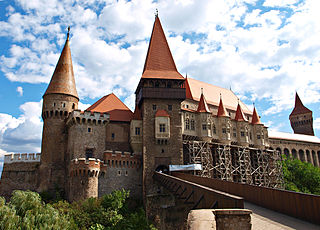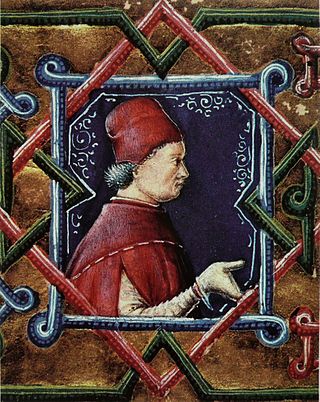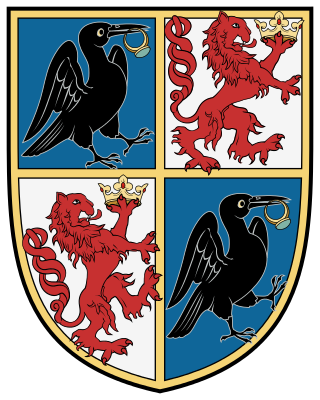
Hunedoara is a city in Hunedoara County, Transylvania, Romania. It is located in southwestern Transylvania near the Poiana Ruscă Mountains, and administers five villages: Boș (Bós), Groș (Grós), Hășdat, Peștișu Mare (Alpestes), and Răcăștia (Rákosd).
Marcus Valerius Messalla Corvinus was a Roman general, author, and patron of literature and art.

Matthias Corvinus was King of Hungary and Croatia from 1458 to 1490, as Matthias I. After conducting several military campaigns, he was elected King of Bohemia in 1469 and adopted the title Duke of Austria in 1487. He was the son of John Hunyadi, Regent of Hungary, who died in 1456. In 1457, Matthias was imprisoned along with his older brother, Ladislaus Hunyadi, on the orders of King Ladislaus the Posthumous. Ladislaus Hunyadi was executed, causing a rebellion that forced King Ladislaus to flee Hungary. After the King died unexpectedly, Matthias's uncle Michael Szilágyi persuaded the Estates to unanimously proclaim the 14-year-old Matthias as king on 24 January 1458. He began his rule under his uncle's guardianship, but he took effective control of government within two weeks.

John Hunyadi was a leading Hungarian military and political figure during the 15th century, who served as regent of the Kingdom of Hungary from 1446 to 1453, under the minor Ladislaus V.

Ślepowron is a Polish coat of arms. It was used by several szlachta families in the times of the Polish–Lithuanian Commonwealth. From the fifteenth century, the descendants of the Ślepowron family began to use names taken from their lands. This led to many different surnames being created within one family, symbolically united under the Korwin (raven) coat of arms, which is thus unique in Polish heraldry. Wawrzęta Korwin de Ślepowron is the oldest known ancestor of the family, although their oral traditions claim descent from Marcus Valerius Corvus, a Roman general.

Korwin is a Polish coat of arms. It was used by several szlachta families in the times of the Polish–Lithuanian Commonwealth and by the Russian Counts Korwin-Litwicki tracing their origin back to Empress Catherine the Great.

Gyula is a town in Békés County, Hungary. The town is best known for its medieval castle and a thermal bath. Ferenc Erkel, the composer of the Hungarian national anthem, and Albrecht Dürer the Elder, the father of Albrecht Dürer, were also born in Gyula.

Corvin Castle, also known as Hunyadi Castle or Hunedoara Castle, is a Gothic-Renaissance castle in Hunedoara, Romania. It is considered one of the largest castles in Europe and is featured as one of the Seven Wonders of Romania.

John Corvinus was the illegitimate son of Matthias Corvinus, King of Hungary, and his mistress, Barbara Edelpöck.

The Black Army, also called the Black Legion/Regiment – were the military forces serving under the reign of King Matthias Corvinus of Hungary. The ancestor and core of this early standing mercenary army appeared in the era of his father John Hunyadi in the early 1440s. The idea of the professional standing mercenary army came from Matthias' juvenile readings about the life of Julius Caesar. The army and its soldiers were among the most renowned and feared military forces of the early Renaissance for their combat abilities and ferocity, and helped pioneer the concept of a standing mercenary army that would soon be adopted across Europe.
Corvinus or Corvin may refer to:

John Vitéz de Zredna was a Hungarian and Croat humanist, diplomat, Latinist, mathematician, astrologist and astronomer. He served as Archbishop of Esztergom from 1465 until his death.

In heraldry, crows, rooks, and ravens are not distinguished from each other. As with all birds that are not eagles, a crow or raven is depicted by default as close, but they can uniquely be blazoned as speaking. Crows may also be called corbies, as in the canting arms of Corbet.

The House of Hunyadi was one of the most powerful noble families in the Kingdom of Hungary during the 15th century. A member of the family, Matthias Corvinus, was King of Hungary from 1458 until 1490, King of Bohemia from 1469 until 1490, and Duke of Austria from 1487 until 1490. His illegitimate son, John Corvinus, ruled the Duchy of Troppau from 1485 until 1501, and five further Silesian duchies, including Bytom, Głubczyce, Loslau, Racibórz, and Tost, from 1485 until 1490. The Hunyadi coat-of-arms depicted a raven with a golden ring in its beak.
The Battle of Leitzersdorf was a battle between the Holy Roman Empire and the Kingdom of Hungary in 1484. Fuelled by the earlier conflicts of Matthias Corvinus and Frederick III, Holy Roman Emperor it marked the end of anti-Ottoman preparations and initiations of a holy war. It was the only open field battle of the Austro-Hungarian War, and the defeat meant – in long terms – the loss of the Archduchy of Austria for the Holy Roman Empire.

The Szilágyi of Horogszeg was an old and important medieval Hungarian noble family, whose members occupied many significant political and military positions in the Kingdom of Hungary and in the Principality of Transylvania.
Barbara Edelpöck was the mistress of Matthias Corvinus, King of Hungary. She gave birth to the King's only, although illegitimate, child, John Corvinus.

Szilágyi – Hunyadi League was a movement led by Michael Szilágyi and his sister Erzsébet Szilágyi, created with the objective of putting Matthias Corvinus on the throne of the Kingdom of Hungary.














